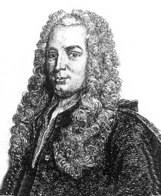

Gabriel Cramer certainly moved rapidly through his education in Geneva, and in 1722 while he was still only 18 years old, he was awarded a doctorate having
submitted a thesis on the theory of sound. Two years later he was competing for the chair of philosophy at the Académie de Clavin in Geneva. He ended up sharing a chair of mathematics there with Calandrini.
They divided up the mathematics courses each would teach - Cramer taught geometry and mechanics while Calandrini taught algebra and
astronomy. While there, Cramer proposed a major innovation, which the Academy accepted,
which was that he taught his courses in French instead of Latin, the traditional language of scholars at that time.
As part of his appointment, Cramer did lots of travelling. He visited leading mathematicians in
many different cities and countries of Europe. He headed straight away for Basel where many leading mathematicians were working, spending five months
working with Johann Bernoulli, and also Euler who soon afterwards headed off to St. Petersburg to be with Daniel Bernoulli. Cramer then visited England
where he met Halley, de Moivre, Stirling, and other mathematicians. From England, Cramer made his way to Paris where he had discussions with Fontenelle,
Maupertuis, Buffon, Clairaut, and others. His discussions with these mathematicians and the continuing correspondence with
them after he returned to Geneva had a big influence on Cramer's work.
Back in Geneva in 1729, Cramer was at work on an entry for the prize set by the Paris Academy for 1730. Cramer's entry was judged as the second best of those received by the Academy, the prize being won by Johann Bernoulli. In 1734, Calandrini was appointed to the chair of philosophy and Cramer became the sole holder of the Chair of Mathematics.
Cramer lived a busy life, for in addition to his teaching and correspondence with many mathematicians, he produced articles of considerable interest,
although these are not of the importance of the articles written by most of the top mathematicians with whom he corresponded. He published articles covering a wide range of
subjects including the study of geometric problems, the history of mathematics, philosophy, and the date of Easter. He published an article on the aurora borealis, and one on law where he applied probability to demonstrate the significance of having independent testimony from 2 or 3 witnesses rather than from a single witness.
His work was not confined to academic areas for he was also interested in local government and served as a member of the Council of Two Hundred in
1734 and of the Council of Seventy in 1749. His work on these councils involved him using his broad mathematical and scientific knowledge, for he
undertook tasks involving artillery, fortification, reconstruction of buildings, excavations, and he acted as an archivist.
Cramer gained a reputation as a skilled editor. Johann Bernoulli's Complete Works was published by Cramer in four volumes in 1742. It shows how much respect that Bernoulli had for Cramer that he insisted that no other edition of his works be published by any editor other than Cramer. In 1745, jointly with Johann Castillon, Cramer published the correspondence between Johann Bernoulli and Leibniz. Cramer also edited a 5 volume work by Christian Wolff.
Cramer's most famous book was Introduction à l'analyse des lignes courbes algébraique. It is a work which Cramer modelled on Newton's memoir on cubic curves.
After an introductory chapter in which types of curves are defined and techniques for drawing their graphs are discussed, Cramer goes on to a second
chapter in which transformations to simplify curves are studied. The third chapter looks at a classification of curves and it is in this chapter that the now
famous Cramer's rule is given. After giving the number of arbitrary constants in an equation of degree n as n(n+3)/2, he deduces that an equation of
degree n can be made to pass through n points. Taking n=5 he gives an example of finding the 5 constants involved in making an equation of degree 2
pass through 5 points. This leads to 5 linear equations in 5 unknowns and he refers the reader to an appendix containing Cramer's rule for their solution.
We should remark, of course, that Cramer was certainly not the first to give this rule.
Cramer's name has sometimes been attached to another problem, namely the Castillon-Cramer problem. This problem, proposed by Cramer to Castillon,
asked how to inscribe a triangle in a circle so that it passed through three given points. Castillon solved the problem 25 years after Cramer's death, and the
problem went on to various generalisations about inscribed polygons in a conic section. Cramer is also known for Cramer's paradox.